What’s there not to love about leopard geckos?
It is a famous beginner pet lizard but also a favorite among seasoned breeders. Many dedicated their careers to these miniature dinosaur look-alikes.
The charming leopard gecko “smiling” is undoubtedly adorable, but unfortunately, it is not a way to tell if your reptile pet is content with his terrarium life. You need to know specific leopard gecko behaviors to tell if they’re happy or in trouble.
Quick Navigation
Quick Points on Leopard Gecko Behavior
- A healthy and well-cared-for leo will be relaxed and resting during the day and active and alert at dusk or night (or whenever you bring out food); his eyes will be bright and clear, and movements typical for the species and energetic.
- Leopard geckos usually hide a lot as they are burrowing animals. However, too much hiding could signal either brumation or sickness.
- Tail wagging and chirping noises are means of communication; they usually warn you to back away and leave them be.
- Behavioral signs of inadequate care or illness include lack of appetite, sluggish movement, awkward leg positions and angles (a potential sign of MBD), rubbing against rocks and decorations, and frequently closed eyes even without intense lighting.
- To understand what makes a healthy leopard gecko behavior, you must also know the basic leo anatomy, especially because they have some specific features that might confuse you. For example, leos blink, lick their eyes and flick their tongues to sense their environment.
Leopard Gecko Anatomy
Leopard geckos are small to medium-sized but sturdily built lizards. Their length ranges from 7 to 8 inches for females and 8 to 10 inches for males. There are giant varieties available from some breeders, too.
Moveable functional eyelids, lack of lamellae on the feet, and dark spots forming various patterns are features special to leos. As for the skin texture, their otherwise velvety skin is evenly covered with small, round, and hard bumps – nothing wrong with these!
Their general anatomy makes them ideally suited for living in the rocky, hilly, arid grasslands of their natural habitat.
If you provide them with a natural setup, your leopard geckos will climb rocks as they have feet with flexible fingers and claws. However, they can’t climb smooth or vertical surfaces.
Their chunky build mirrors the fact that they are not really adapted to an active lifestyle – hiding and burrowing are among the top activities (when not hunting or looking for a mate). Still, when they have to, leos will run reasonably fast.
Leopard Gecko Eyes
Leopard geckos can blink – the movable eyelids add to their charm significantly. Eyelids are a convenient feature because they reduce the chance of eye injury in the wild and in the enclosure.
Leopard geckos’ sight works well both in the light and in the dark because they are adapted to a crepuscular lifestyle. This means that they are most active in the twilight, but they do have random intervals of activity throughout the day, too, depending on their needs and outer stimuli.
Despite their eyes being almost mammal-like at first glance, they lack many characteristics of a mammalian eye. That includes the production of tears. The lack of tears explains why your leos lick their eyes to keep them clean and moist.
While eye licking is typical, repetitive eye licking and blinking can mean that your leo has something stuck in the eye or is painful.
Leopard Gecko Ears
Right behind the eyes, leopard geckos have ears that look like simple holes on the sides of their heads. But look closely, and you will notice a thin, transparent eardrum. The ears are very sensitive to sound and vibration, which helps them hunt prey, avoid predation, and presumably communicate since they can also vocalize when threatened.
Leopard Gecko Mouth and Tongue
Leopard geckos have small, sharp teeth in their mouth that they use to lacerate insects they feed on. From a human perspective, leo’s teeth are tiny and non-threatening. Their accidental nip feels much more like a pinch than a bite.
The “bite” rarely draws blood, though I (painfully) learned that they could hold on for quite some time before letting go, especially when hungry.
Leopard geckos almost never bite to attack their owner. The nips frequently occur if you feed them out of your hand since your lizards can easily mistake your moving finger for food.
One of the amusing anatomical features of leos is their adorable tongue. Like all lizards and snakes, leopard geckos have Jacobson’s organ on the tips of their tongues. The small olfactory organ is what provides them the sense of smell – lizards flick their tongues to smell their environment.
Leo’s tongue flick is not as fast and menacing as those of snakes; their tongues are somewhat stubby. They look like licking the air, which adds to their charm.
> Further Reading: Mouth Rot in Leopard Geckos
Leopard Gecko Tail
Leos’ tails are substantially fatty. They use their tails to store fat and water in the case of unfavorable conditions in their often-harsh habitat. It allows them to survive for a significant time with no food or water.
Tail Shedding
Leopard geckos can lose their tail if they get caught or bitten on it. The detached tail can continue to move on its own for as long as 30 minutes. This evolutionary mechanism is devised so that while the predator is busy with the moving tail, the “owner” of the tail – that is, the gecko – can escape into safety.
The tail will grow back but never look the same as the old one. It will usually be more stubby and have a different color pattern than the rest of the body.
Be aware: your leopard gecko can shed its tail. You should never try to pick it up by its tail. Also, be sure that its habitat is safe and stable for crawling around.
> Further Reading: The Leopard Gecko Care Sheet
Sexual Dimorphism
The sexes of geckos differ in subtle ways. Like in many animals, male geckos are bulkier and heavier than their ladies. However, due to the natural variability of this feature, it is not a reliable basis for sexing geckos.
The most reliable way to tell the difference between a male and a female gecko is to look at their belly, specifically the ventral side of the tail base. There, you will notice a line – the cloacal opening.
On the side of the opening closer to the tail, males will have two small symmetrical bulges. This is where their hemipenis is located. On the side of the cloacal opening closer to the belly, males have pores that form a V-shaped dotted pattern. Females lack both of these characteristics – their ventral side is smooth and even.
There are behavioral differences as well. Mature males housed with females will pursue them and use tail shakes to get their attention. In these settings, if a gecko keeps its tail waving at others, it is likely a male.
Geckos can be precisely sexed only when they are over six months old or 5 or 6 inches long. Younger males will often look like females.
Leopard Gecko Behavior and Body Language
Leopard geckos are not social animals. However, they display a moderate amount of social communication through their body language. Their behavior can signal their health and well-being. It is then important for a gecko owner to know how to interpret them.
Leopard geckos use various signals to communicate with their environment.
You will observe all aspects of body language more frequently in juveniles and young geckos. In case these behaviors (e.g., the tail shakes) diminish as your gecko gets older – everything is fine, it happens commonly.
Tail Shaking and Wiggling
The tail is the main tool of communication between geckos. They will use slow wiggling to inform others of their presence. A male will use a specific wiggle when he wants to introduce himself to females.
The more vigorous shakes can be defensive, appearing when a leo feels threatened, irritated, or come under an attack.
In defensive situations, the tail is used as a distraction since a leopard gecko can afford to lose a tail to save his life. Energetic shakes can occur in offensive situations as well, such as when the gecko is delivering an attack or hunting.
Sometimes, your leopard gecko will shake energetically its tail when you try to handle it. It is a sign that it is not used to your hands and your presence enough. At this point, if you try to pick it, your leo will try to escape. This might result in a tail drop or a bite.
If that happens: try to keep your hand in the vivarium for a while, but at a safe distance.
Shaking Head and Swaying
You can observe this behavior while your gecko is swallowing a larger insect – he will sway his head from side to side. The movement helps your lizard pass the food from his throat to his stomach, which is entirely natural. To avoid digestion problems, I would advise giving your geckos insects that are smaller than the space between their eyes.
Sometimes, head swaying occurs independent of food intake, especially if it is followed by vocalization. It could mean that your leo has something stuck in his throat.
Noises and Meanings: Chirping and Squeaking Sounds
All geckos can produce chirping and squeaking sounds. They will usually squeak when they feel threatened. The sudden nature of a chirp is indicative of its evolutionary role. It is likely devised to startle the potential predator.
Although these sounds are entertaining, please abstain from provoking your gecko to squeak or chirp since it means you’re stressing him.
Some geckos also seem to vocalize when they’re in pain, so pay close attention if you hear squealing for no obvious reason in mature animals.
Tank Climbing and Glass Surfing
All leos will try to climb the tank’s glass at one point or another, and this is normal. My geckos seem to believe this will get them more food. However, terrarium climbing can be a sign that something’s wrong in their environment and that they are trying to escape it.
When you notice tank climbing, make sure:
- That temperature in the terrarium is within the normal range; too much heat could cause glass surfing
- That the gecko is not being attacked by others (we don’t recommend cohabitation).
- That there are no mites in the substrate or on the geckos,
- The enclosure is sufficiently large and has enough surfaces for climbing and hiding.
Hiding
Being mostly crepuscular animals, most of the leopard geckos will hide during the day. My geckos tend to get active around 6 PM, and as dawn approaches they will go to sleep again. They are sound asleep by the time morning comes.
If your gecko has been hiding for 24 hours or more, check on him. Rather than pulling him out of his hiding place, try to bribe him out with food or other tactics (see “Training”) since this will provide you with a better conclusion about the state they are in.
The most common reason for excessive hiding is that the tank is too cold, so check the temperature. If the temperature seems to be within the desirable range, and the gecko doesn’t react to food or other stimuli, consider other health issues.
> Further Reading: Leopard Gecko Habitat: How to Setup the Ideal Tank?
“Training”
You can’t train a gecko in the real sense of the word, but you can create a reflex so they will react to specific cues. The most obvious interest of your gecko is, of course, food. There are few other things to consider when you are a lizard. Leos have decent appetites, and you can use their interest in feeding to “train” them.
My geckos know the food is coming when I tap on their tank. I used gently to tap my nails on the glass before feeding them, and in time learned to connect the sound and the vibration with their meals (also – gecko ASMR, maybe?)
Consequentially, whenever I tap, they come running towards the front glass. Besides impressing my guests, this comes as useful when they’ve been hiding for a while, and I’d like to do a quick check if they are responsive and healthy.
When it comes to toilet training, leopard geckos come “pre-trained”. They will pick one corner of the tank and go there nearly every time. This is not the consequence of any sort of training – it is just their natural behavior.
> Further Reading: What Do Leopard Gecko Eat?
Do Leopard Geckos Have Personality?
The question of whether reptiles have personality in the true sense of the word is always a cause for debate. While some owners will swear about the connection they share with their cold-blooded pets. Others dismiss this as a clear case of anthropomorphization – indeed, with their smiling faces, blinking eyes, and lively behavior, leos are ideal for projecting human or mammalian traits.
Yet, while they display social behaviors, reptiles are not truly social creatures. Their brains lack certain parts that are found in social mammals. This is crucial for high-level emotional processing and social bonding. Therefore, as far as we know, they can’t truly bond with their owners like a dog or a rat can.
You can tame them; they can learn to recognize when a family member appears in front of their terrarium or enjoy the warmth of your hands. But leopard geckos don’t really need to be held or petted as social mammals do. Keep this in mind when deciding how much you want to handle your leo. Too much handling or acrobatics, such as putting him on your shoulder, can be stressful (and unnecessarily so).
While your leopard gecko might lack advanced social skills and a profound emotional life, that doesn’t mean he lacks characteristics that make him unique. In my experience, individual leos have many personal preferences and behavioral quirks, which we could loosely call “a character” or “a personality.” Some will prefer certain foods; some vocalize more than others; some like to hide while others rest stretched out in the open; some don’t mind being handled, and others do. If you have a couple or several individuals, comparing their characters promises a lot of fun.
In any case, loving your pet will do you all good, even if the love is not completely mutual.
Leopard Gecko Health & Diseases
Although leopard geckos are healthy and hardy as a species, naturally, certain health conditions can affect them. As you will see, most of them are related to bad rearing and keeping practices. Fortunately, that also means that most of them are easily preventable.
Let’s explore the most common leopard gecko health issues.
Impaction
Leopard gecko impaction occurs when they accidentally swallow foreign objects or inadequate substrate or eat insects that are too big or have hard shells. In all cases, the indigestible material blocks their intestines. If not treated, impaction can result in the death of your pet.
The signs to watch out for are failing to pass stool, food rejection, sluggishness, bloating, and changes in the color of the abdomen.
If you believe your leo might have an impaction, the first thing to try is to give them a lukewarm bath/swim. The water level should not be above his shoulders, as you don’t want to drown him. Spending time in the water is slightly stressful for a gecko, but the swimming movement could help him pass stool.
If the baths fail, contact a reptile vet immediately. Impaction is usually difficult to treat, so it is best to prevent it instead. Be careful not to give your gecko hard foods or equip your terrarium with inadequate substrates a leo could swallow – especially if you are letting your leo hunt freely around the terrarium.
Egg binding in females can sometimes be mistaken for impaction. We will discuss this condition in our article about breeding.
> Further Reading: The Best Leopard Gecko Substrates
Incomplete Shedding
A healthy gecko’s old skin will come off all in one piece. However, if the environment is too dry, or there are other underlying health issues or mineral deficiencies, pieces of old skin can remain stuck on certain parts of the body. It is essential that you remove them to avoid further complications. For example, leos can lose fingers due to hardened old skin “rings” that stop the blood flow.
Be careful to not pull the skin when it is not necessary as you can hurt your leo this way.
> Further reading: Leopard gecko shedding guide
Metabolic Bone Disease (MBD)
Metabolic Bone Disease, or MBD, is similar to rickets in humans. Because of the lack of important minerals or vitamin D, bones become soft and deformed, resulting in leopard geckos being unable to move or even eat properly because of a deformed jaw. MBD demands the immediate start of treatment with calcium, vitamin D3, and UVB lighting.
Behavioral signs include lethargy, strange walking, closed eyes, and usually a lack of appetite (the jaw also gets painful as the disease progresses).
The treatment will not be able to correct the damage that has already taken place, but it will stop disease progression. Always be mindful that young leos are at greater risk for MBD, especially during the first year of their life, so make sure they are getting their supplements. Adding a low-to-medium intensity UVB light for shade dwellers is also a great way to prevent MBD, despite leos not being avid baskers.
External Parasites – Mites
Mites are the most common external parasites in terrariums. These tiny tick-like invertebrates will pierce your gecko’s skin and feed on his blood. Also, they will live and breed in the gecko’s terrarium.
Consequently, a leo affected by mites might rub his or her head and other body parts against rocks and other tank decorations. Also, they may appear stressed.
Internal Parasites
Sometimes, a gecko may get internal or gut parasites. The infection usually occurs through food or unsterilized enclosure material. Typical signs include weight loss, lethargy, and messy stools.
A vet will need to get a stool sample to confirm an endoparasitic infection. Some treatments can reduce the number of parasites and perhaps help save your gecko. I need to underline that proper vet support is essential if you are dealing with internal parasites.
Besides quality care, the best prevention against spreading parasites and all other diseases in your reptile collection is to put all newly acquired geckos in quarantine for a period of watching and assessment, lasting as much as three months.
> Further reading: Leopard gecko dying signs
Take Care!
I hope you now better understand what your leo means and wants when he’s tail waving, glass surfing, or licking his eyeballs! Offering the best possible living conditions, with adequate food and supplementation, will ensure your leo lives a long and happy life – and then, you can let yourself believe that that gecko smile is getting a true message across!
Glossary
Anatomy – a field in the biological sciences which is dedicated to identification and description of body structures.
Anthropomorphization – the act of attributing human characteristics or personality traits to animals
Crepuscular – animal mostly active at twilight
Eublepharis – a genus of lizards that the common leopard gecko, Eublepharis macularis, belongs to. It consists of 6 similar species.
Jacobson’s organ – also known as the vomeronasal organ, it is an olfactory sense organ found in many animals, including all reptiles and many mammals.
Lamellae – special padding found on the pads of gecko’s feet, allows them to climb smooth vertical surfaces by utilizing the electrodynamic force.
Sexual dimorphism – the difference between male and female individuals of the same species.

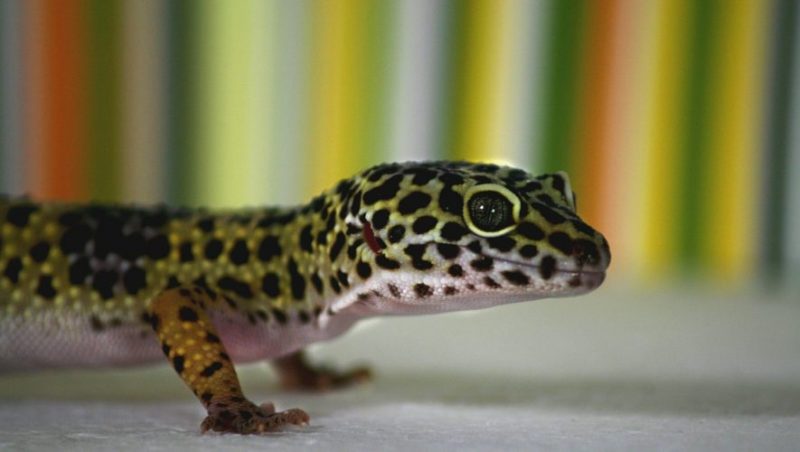



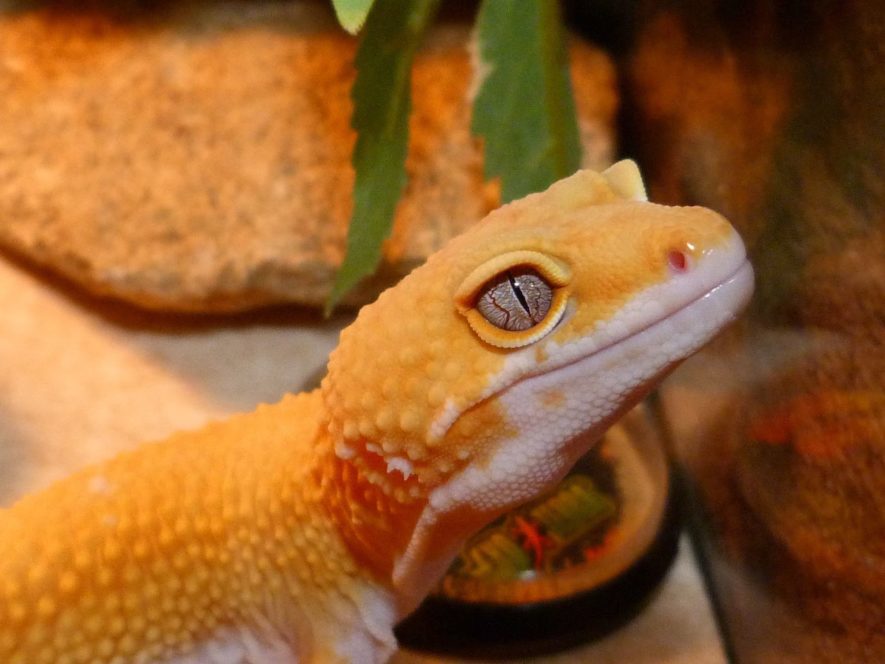
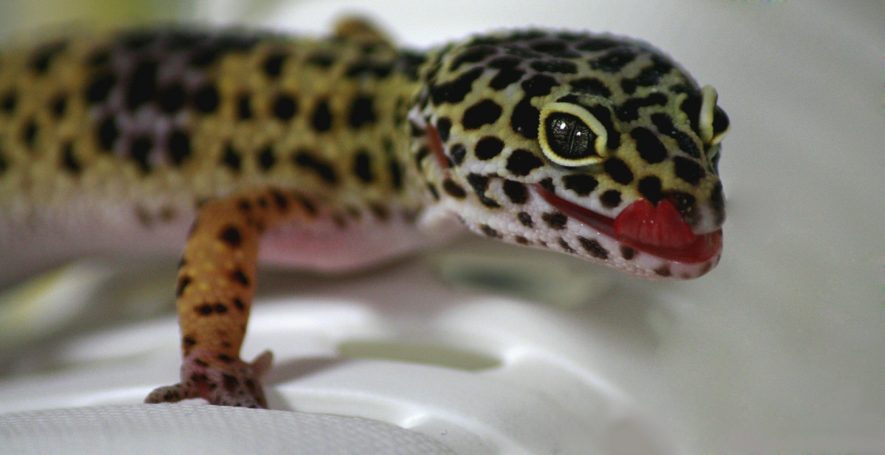
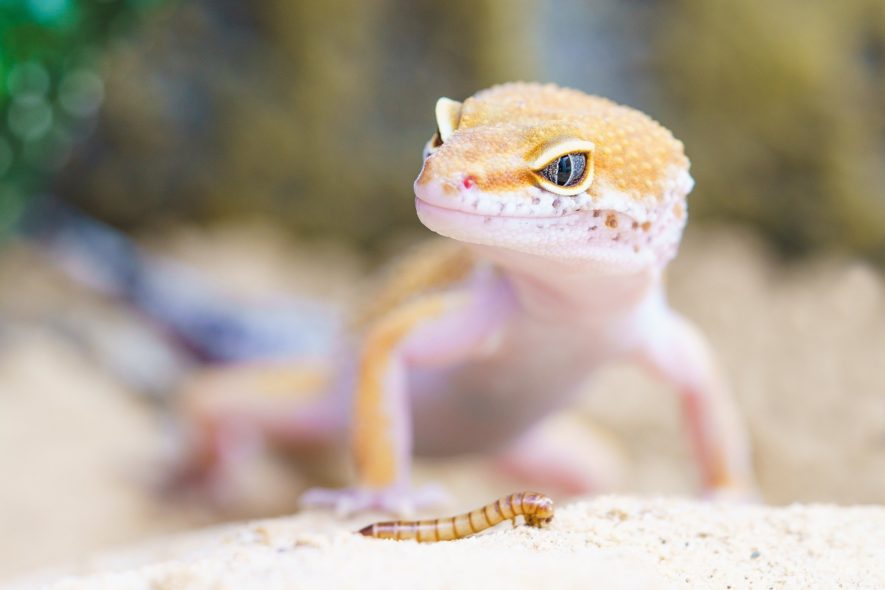
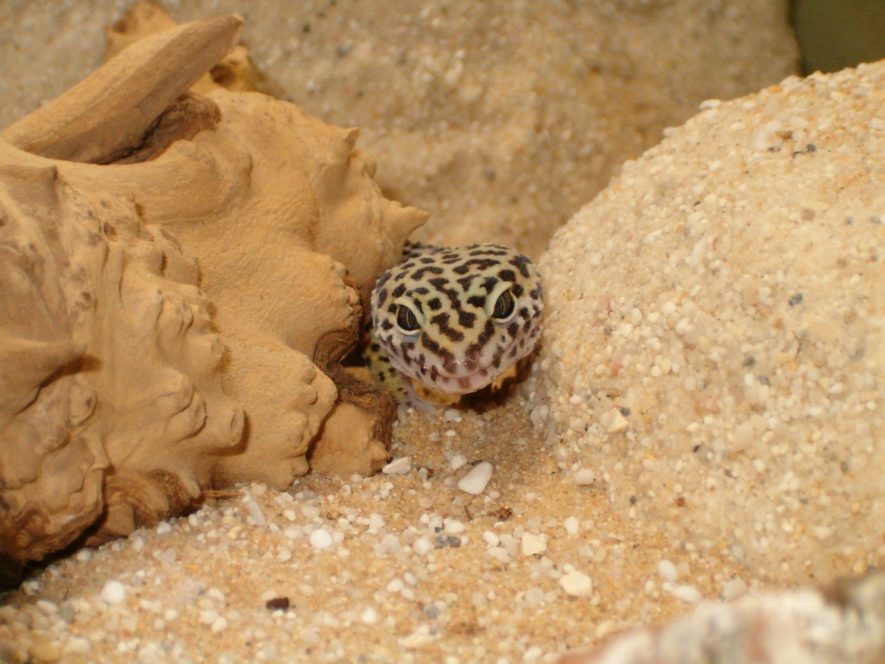
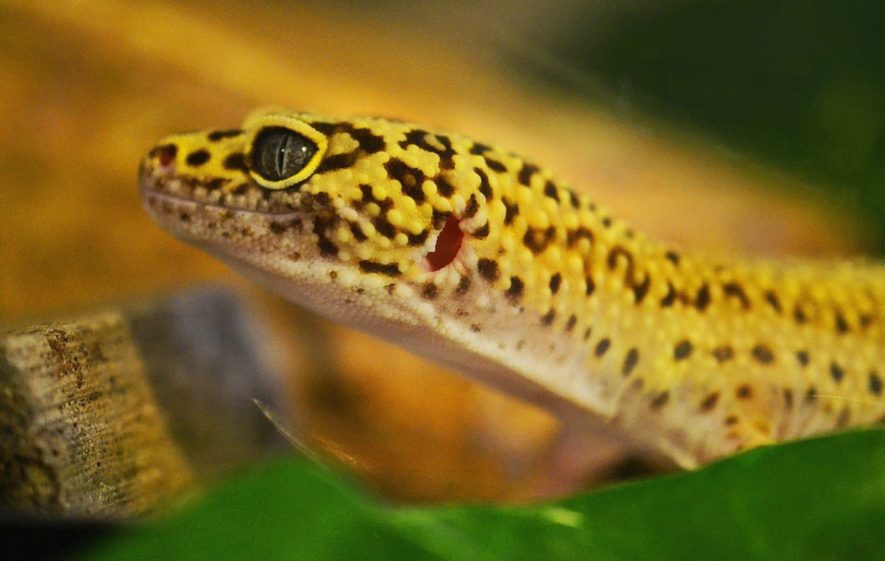
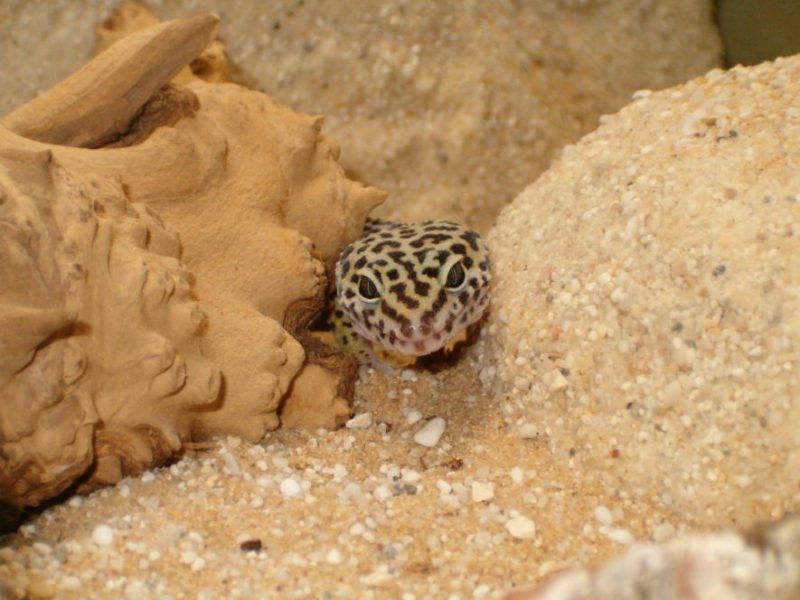

43 Comments
My gecko was having trouble shedding, and his eye is now leaking red fluid that’s clear but red. All I can think is that, I hurt his eye somehow when I gave him a shallow bath to help with the shed, he hurt his eye when he’s been rubbing his head on the rock hide in his tank or he’s got the vitamin a deficiency. He also hasn’t pooped in a few days which is unusual for him. He is still eating though he had a bit of trouble catching and swallowing the worm though. I’m just really worried about Calcifer, he’s a member of my family!
Hi Devon,
Based on what you wrote, it is possible that your gecko suffered an eye injury while rubbing his head. Please check for structures in the tank that are too rough or sharp and remove them. Also, it could be a nasty eye infection unrelated to the shedding itself.
About vitamins, are you supplementing properly with quality multivitamin and mineral powder, plus extra pure calcium as needed?
Also, I wonder if his moist hide is moist enough – there is no need to give baths. I like to give my geckos peace when they’re shedding – they always find their way to the moist hide, and no additional water is needed. Rubbing too hard can signal difficult shedding and it is good to pinpoint the reason.
As for treatment – I am not a veterinarian, so I can only say that you can flush his eye with a normal sterile saline solution as a first measure. Now, what would you do for a family member that’s bleeding and at risk of an infection? Take him to the doctor, of course. It would be best if you took Calcifer to a specialized reptile vet. Also, you can check out the Ask a Vet option on our homepage. Good luck!
5 year leo owner here. Very well written and comprehensive. Well done.
Hi, I have a 1 year old leopard gecko named Echo. He was perfectly fine when we got him around 7-8 months old. My boyfriend got him for me as a present for our 8 months. He was easy to handle, feed, and was very active. Here recently it has seemed he’s gotten more aggressive. Anytime I try to feed him he will barely eat. He will act like he’s going to go eat and then backs away and let the mealworms get away. His temperature stays around 80 and his humidity is around 45. I know I need to get him a bigger tank and I plan to in the next month or so. The other day my boyfriend tried handling him and he bit him. And it almost seemed like when he went to run off he was having issues. He was fine afterwards but it was scary. I can’t clean his tank or even put my hands near the glass without him trying to bite me. Is there anything i should do? There’s no stuck shed that I see and he’s still active at night.
Hi Nevaeh,
I’m sorry for your trouble with your leo.
Having a leopard gecko bite you out of aggression (e.g., without mistaking your fingers for prey) is extremely rare.
There are some instances when male geckos get jumpy and sort of aggressive as the breeding season sets in, but it rarely ends in biting.
I suppose you have no female geckos in the same room.
The situation is definitely watch-and-wait, but here are some things I would do.
– Don’t try to handle him at all for some time
– Watch out for signs of stress and injury and take him to a reptile vet if something seems too off.
– Make sure that the daylights are not too bright.
Also, put mealworms in a shallow tray they can’t get away from.
After Echo seems stable, you can try taming him again, but slowly.
Good luck!
I have two 3 year old geckos for the past year and everything is great but starting last week one of them stopped eating and has not come out of their cave at all. It’s starting to worry me and I have no clue what to do. The other gecko is fine but she never hides.
Hey Johanna,
The most common reason for excessive hiding is that the tank is too cold, so be sure to check the temperature first. If it seems to be within a desirable range and the gecko doesn’t react to food or other stimuli, consider other health issues and consult a reptile veterinarian.
You can find more information about stress conditions in your geckos here.
My young Leo will sleep flat with her head propped up on the glass as she looks straight up….is this normal? It looks very uncomfortable but she does it quite often.
Hey Heather,
Yes, it is perfectly normal for your Leo to sleep in this position. Geckos often do so when they are basking. It is their way of relaxing and getting comfortable. If your gecko is healthy and happy, there is no need to worry about this sleeping position. Thanks!
First of all thank you very much for the wonderful resources. I looked and read my sites and this is by far the best! We got our leo about two weeks ago. We are keeping a hands-off approach until she aclimates, but I noticed that she is going to the bathroom in the humid hide. I clean every day, and keep it moist, but this is far from ideal and I am wonder what I can do.
She seems to spend most time in the warm hide and just use the humid as her bathroom. Any tips are more than welcomed. Thank you
Hey Juliana,
It seems your Leo is a bit slow at adapting to its new home.
Leopard Geckos have a habit of using the same area for pooping, and so does your Leo.
Additionally, geckos require humidity of 30% -40% at the cooler end of the tank maybe you have failed in maintaining humidity at that level so your pet avoids humid hide until it has to defecate at its favorite place. You should also check if you are maintaining the temperature of moist hide between 83 to 90 degrees Fahrenheit.
Hope it helps, have a good time!
My daughter had had her Leo for about 3 months. When she got him he was tiny… not sure how old he is but he has never been a great eater. She’s always had to either hand feed him or put worms right in front of him and keep moving them back into the little dish we have because he lets them get away. He had been super active and moving a lot and trying to climb up her and hide under her hair but for the last few days he is just lethargic and not moving around very much and has no appetite at all. Not sure how to help her help him. I’ve read thru most of the comments and questions from previous people. Everything we have with already tried short of going to the vet. … that’s obviously the next step but didn’t know if we should wait a little longer. How long is to long for him to not eat? I read someone who said their gecko didn’t eat for 3 weeks??? I don’t know…
-Concerned Leo Grandma
Hi Chantel,
You may have already done so but double check your temperatures, make sure his moist hide is clean and damp. Does he have plenty of places to hide, what lighting setup do you have? Shedding can prevent geckos from eating, make sure he doesn’t have any shed skin stuck to him. You could also put him in a clear container and look at his belly, check for any significantly dark patches that could be a sign of impaction. I would be concerned if he doesn’t eat for more than 10 days or loses a significant amount of weight quickly. If this persists get him checked over by a vet.
My Leopard gecko is becoming lazy and I want him to get more exercise. Is there any way? Also is it normal that he is turning yellow and yellow every time he sheds?
Hi Chloe,
Don’t forget, your leopard gecko is nocturnal and so more active at night when you are sleeping, it is normal for him to sleep during the day. Just check that your temperatures are correct as they need warmth to be able to move around. When reptiles are coming up to shed they become dull, so when the new skin is revealed it will appear brighter, this is completely normal.
Hi!! I have a 14 year old albino leopard gecko and after some skin shedding issues it seems like his eyes aren’t functioning properly. I’m not sure if he can see and now is losing weight due to not eating or seeing the food. Is he getting old or has a disease? I’m so worried. Thank you! Nat
Hey, Nat.
Your pet is certainly no spring chicken! That doesn’t mean he can’t live for several more years, but it is possible that he’s (unfortunately) starting to decline.
We’d recommend taking him in for an examination by your vet. He may be struggling with illnesses you can treat, which may extend his life even further.
Regardless, you’ve certainly done a great job with him! Not many leopard geckos live that long!
Thank you for your great advice and kind words. The lifespan is wide ranging on various sites and then you read about some people having them for 32 years. I appreciate your help!
Thank you for your great advice and kind words. The lifespan is wide ranging on various sites and then you read about some people having them for 32 years. I appreciate your help!
Hey guys! So I have a curiosity question. We have a baby leo he is about 7 months old I would guess. Anyway, whenever I hold him, he will lick my palm and then lay his chin down and rub his chin all over my hand back and forth until he covers my entire palm. Then he wants to go to my other hand to do the same. He doesn’t have stuck shed or anything like that. It’s super cute but I was wondering if any of you knew if they scent mark like that. Its more of a curiosity, I’m not worried. I have other geckos and none of them do this, only him. Hope you all are staying safe and have happy holidays!!
Hey there, Kira.
Leopard geckos will scent mark, but this is normally done by rubbing their vent area on the ground, rather than their chins. We’re not sure exactly what he may be doing, but we agree – as long as he’s acting healthy otherwise – it’s probably no cause for concern.
Good on you for being so observant of your pet though!
Hi, so my daughter left to the Marines and she left her betta fish and a one year old gecko. The gecko lives in a 60 gallon tank with all the things she needs, but Recently she is trying to climb the glass and looking for attention. Neither my husband or my teen boys or me have the courage to carry her like my daughter would ( she used to put her under her t-shirt)she is chasing the crickets but not with energy, also she does not want the meal worms( I reheated under the lamp so they are alive again) so after a few hour of reading about geckos I had purchased a new carpet and new climbing place, thermometer humidity gauge and moss to see what happens. Is the gecko trying to tell me something?
Thanks
Hey, Angelica.
First of all, I just want to applaud your daughter for providing her gecko with such a large habitat. That’s wonderful, and I wish more people would follow her lead! Secondly, I want to applaud you for trying so hard to take care of your daughter’s pet!
But unfortunately, it’s hard to know exactly what’s going on here, without seeing everything up close.
I wouldn’t worry about her looking for attention; leopard geckos are not really social creatures.
But the apparent loss of appetite is a bit concerning.
It could just indicate she’s going through a shedding cycle. Does she look “faded” or do her eyes look strange?
If that’s the issue, she should just perk back up once she sheds.
Also, lizards occasionally develop preferences for some insects over others, and refusing mealworms is not really a huge problem.
Crickets are the better food item by far.
But the loss of appetite may indicate a health problem too – again, we just can’t tell from afar.
As always, I recommend starting by double-checking all of the habitat temperatures. You’re looking for temperatures on the warm side of the habitat in the high 80s (no higher than 90), while the cool side should be in the low 70s (if possible).
You may also want to try some different types of insects. Feeder roaches, silkworms, and superworms are good options.
Give her a few days to a week and see if her appetite improves a little, and she starts acting normally again. If she doesn’t, or she starts exhibiting any other signs (bubbles from the nose, lethargy, etc.), get her to your vet ASAP.
Best of luck and thanks for reading the site!
She is five months old and I dont know when her first shed is suppose to happen
Hi Debra, We just published a guide about shedding. You might want to have a look at it. Let us know if you didn’t find your answer there 🙂
Not sure what to do at this point , my gecko will not eat , she has laid eggs on 4 occasions over the last 2 years , which I bought her as a juvenile and have only had her for 2 years , I’ve read the suggested actions , and gave her a bath , I’m hoping it helps , she has not ate in 3 weeks and her tail is shrinking, I had my last leopard for almost 24 years with no issues at all , any suggestions would help , starting to get worried at this point
Hey, Brandon.
So sorry to hear about your gal! (Also sorry that it took me so long to respond.)
I hope she’s doing better now, but if not:
We should always reach out for veterinary help anytime a pet exhibits a serious symptom, like not eating for an extended period of time. But that’ a bit problematic with reproductively active lizards, as fasts are pretty common at times.
So, you’ll just have to use your judgement. An occasional bath is rarely a bad idea, but make sure you double-check your habitat temperatures, just to be safe.
I worry that it could be a sign of a reproductive complication, so I really think this is probably a vet situation at this point.
Best of luck! My fingers are crossed for your leo!
Hi! My daughter got a female gecko back in feb! She was great and happy but the last month she has become very aggressive to the point we can’t put our hands in the tank to feed her or clean her tank, without her trying to attack us! What should we do? Everything is fine with her habitat, she moves around, climbs, hides in her long, temp is good, just very aggressive when we need to put our hands in it! We have never been able to handle her cause she would always run away, but now we can’t even get her out to clean the tank
Hey, Jessica.
It’s certainly not common, but a very small percentage of leopard geckos can become rather aggressive. Sorry to be the bearer of bad news, but your daughter’s pet sounds like she may be one of the aggressive ones.
There’s not really a lot I can recommend doing, aside from using a container to “scoop” her up when it is time to remove her or clean her cage. You may find that handling her very gently over time helps calm her down, but you may take a nip or two while trying. Leopard gecko bites aren’t really serious, but they can deliver a surprisingly strong pinch. But, a think pair of outdoor gloves would render her bites meaningless, so you may want to invest in a pair and try them out.
Sorry I don’t have better news for you. Best of luck!
I got my little guy around a month ago, he’s roughly 1-2 months and he’s been getting much better in his feeding routine and will come out around dinner time to get his food. I do notice that he’s much more active when the outdoor temperature is very warm. Could it be his tank is slightly too cold for him? He has also started ‘sliding’ along the bottom of the tank in his cold hide (for want of a better description) and I have read this can be to mark their scent, is this true? He looks a bit strange whilst doing it but doesn’t appear to need to shed which would be my first thought.
Hey, Shelley.
Sorry for my delayed response.
It sounds like his habitat may, in fact, be a bit cool. So, (gently) bump up the temperatures just a bit and see if that helps. We should always “listen to our lizards,” rather than going by temperature guidelines we or anyone else offers. Those are always a good starting point, but always let your thermometer and observation of your pet guide your efforts. Just be sure to make any changes gradually.
And yes, the behavior you describe sounds to me like he’s depositing secretions – likely for a territorial/mating reason.
Thanks for reading!
My leopard gecko has been fine recently, eating well, and looking overall healthy. But recently she stopped eating. She looks fine, but she is more lazy, though not aggressive. Since it is March, I don’t know if she may be ovulating or not. She won’t let me check, and I don’t want to hurt her or make her uncomfortable. What should I do? And if she is ovulating, is there anything I should do to help?
Hey, Sophie.
It’s hard to tell what’s going on with your little lady from across the internet. Can you see eggs through her ventral skin? It’s usually possible to make them out as she approaches her egg-deposition date. Developing eggs may cause a leopard gecko to stop feeding and remain inactive, but so can respiratory infections.
I’d recommend giving your vet a call if she doesn’t resume normal behavior in a couple of days.
Let us know how it goes!
My Leopard Gecko is a bby and I noticed that I never seen him eat a mealworm. I bought two cans from Petco and I left 3 mealworms in the tank and every day the mealworms are still in the tank. I was thinking is it because the mealworms are dead
I have found that my two geckos dont and won’t ever eat the freeze-dried. As they are ( and usually as a species) movement based hunting. You might have to try live feeding if they won’t eat. I also would suggest mixing it up like with both mealworms, superworms and crickets! As a mix in diet is good!
My leo suddenly started to spend more time out in the warmer half of his tank.It is summer so the temperature overall its warmer.Before he usually was in his wet cave all day and came out in the evening.
I have also noticed that he is stinky and had diarrhea like stool for the last 2 days.
Otherwise he is eating well, hunting his crickets and looking healty.
Any suggestions?
Hey, Tina.
Sorry it took us so long to respond. Hopefully, this will still be helpful (to you, or some other reader).
I wouldn’t worry about a brief period of stomach upset – particularly if your gecko is still eating well and looks healthy. However, if the bad stools continue, I’d head to the vet to have your pet examined.
As for the change in thermoregulation, I’d recommend double-checking your habitat temperatures first. If the temperatures are in the acceptable range, and your lizard is acting healthy otherwise, I wouldn’t worry very much. Sometimes leopard geckos (and all other animals) just change things up.
Best of luck!
About the summer part, a lot of the time people tend to make the decision of not changing the tempurature of their tank because the heat of the home is changing. though the atmosphere around the tank may be warm or cool, the thickness of the glass sometime soon won’t effect the tempurature of the inside of the tank. it’s a good thing that’s you stay aware of this behavior because worse comes to worse, you can just crank up the heat. i hope his helped!
Yes that’s right my Gecko likes the chase of real mill worms. Like in the wild they have to chase there food and he will eat them when there moving only if it looks dead Winston won’t eat them so live mill worms are the best you can get them at any pet store Zamzows and crickets they like too!!
Ya remember leopard geckos don’t have the best eye sight so it helps them to see the worms or whatever they are hunting for food. I have come to find with my little guys they love the live mealworms. Hopefully this helps
My leopard gecko only likes to eat the alive ones aswell, and I was worried too but then I gave her live ones an dshe ate them right away
Go live bugs
Thank you for this great article, I have 2 leopard geckos and I love them so much! I’m always interested in learning health issues and tips for them!